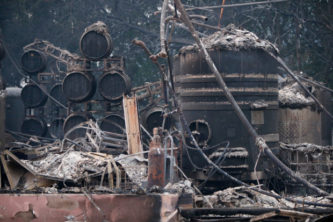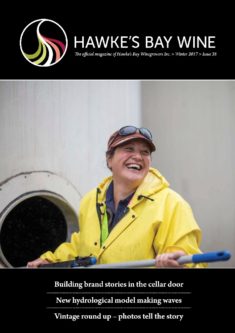As the California wildfires raged, with Mendocino, Napa and Sonoma counties being the hardest hit, the focus of authorities rightfully remained on rescuing people trapped in or near the inferno and attempting to control the fire. But the impact on California’s Wine Country continues to grow, with several wineries damaged or destroyed. That won’t have an immediate impact on wine lovers, but it could dramatically affect the supply and even the taste of Napa and Sonoma wines for years to come. Alex Andrawes, a wine broker in Texas and owner of PersonalWine.com has extensive contacts in Napa. One of his friends “said he could hear the wine boiling in the barrels before the roof fell in.”

The lasting impact of the Napa fires could affect all wines coming from California, whether they’re caught in the fires or not. “The smoke taint thing will be global — both valleys,” he says. “No pockets spared, I fear.” With the first wildfire still burning, the list of wineries that suffered damage may increase.
Authorities haven’t yet put together a complete list of wineries burned by the wildfires. Napa Valley Vintners, which has heard from 160 member wineries, says at least five of its members have reported total or very significant losses, with 11 more reporting some damage to their winery or vineyards. Several members have not yet been able to access their properties to assess the damage. The group is still not naming which wineries have been impacted yet and says it’s too early to estimate the economic impact of the fires on Napa’s wine industry. Here’s where Northern California’s wineries stood in the later stages of the fires:
Napa County wineries

Signorello Vineyard cellar door destroyed by California fires, Oct 2017 Signorello Vineyard – While the winery itself was completely destroyed by flames, early indications are that the vineyard might have survived. That’s potentially good news since replanted vines take several years to mature.
- Stags’ Leap Winery – While the fires certainly impacted the winery, the extent of the damage is still unknown at this time.
- White Rock Vineyards – One of Napa’s oldest wineries (founded in 1870), White Rock initially said all employees were safe and it planned to assess damage on Oct 10th. Unfortunately, it later confirmed the winery was a total loss. The state of the vineyard is unknown.
- William Hill Estate Winery – Footage of the winery’s sign burning that went viral, it turns out the damage to the actual winery is mostly cosmetic. Officials say vineyard damage was minimal.
- Darioush – The Stag’s Leap District winery suffered some landscape and vineyard damage, but said the winery structure was sound, despite some reports that were more dire.
- Hagafen Cellars – While the winery building and tasting room survived, the crush pad at the back of the winery was burned and all agricultural equipment and 1 acre of the winery’s Cabernet Sauvignon vineyard was burned. “What this all will mean for vintage 2017 is yet to be determined. Much of our wine is already inside and resting in barrels. As for vintage 2018, I am reasonably certain that we will continue, repair the damage, replace the equipment needed, etc.,” the winery said.
- Helena View Johnston Vineyards – The Mercury News spoke with the owner’s brother, who told them “all is lost” at the organic winery.
- Segassia Vineyard – The Patrick Road fire damaged this Atlas Peak winery. The extent of the damage however, is still being determined.
- VinRoc – This small-batch family winery, which makes no more than 1,000 cases per year, reportedly suffered a “total loss”. Proprietor and winemaker Michael Parmenter told local media “everything gone except our (wine) cave.”
Sonoma County Wineries

Paradise Ridge Winery sits destroyed in the foothills above Santa Rosa, California, in the wake of the Tubbs Fire, Monday evening, Oct. 9, 2017. (Karl Mondon/Bay Area News Group) Paradise Ridge Winery – The winery reported a total loss. In a Wednesday morning post, though, it said all employees were safe and vowed to rebuild.
- Ancient Oak Cellars – This Russian River Valley winery suffered heavy damages, with the tasting counter, two onsite redwood barns and the owner’s house being destroyed, the company said. There was some good news the next day, though, as the owners informed “although we have not been allowed on the property yet, we were able to look from afar and we *believe* that our vines may have been spared. It’s too early to know for sure, but we see green, and not all scorched black as we feared.”
- Sky Vineyards – There’s reportedly some fire damage here, but the facility is still standing. As of now, though, the extent of the damage is unknown.
- Nicholson Ranch – There’s some damage here, but the winery said on its Facebook page that the wine was secure in its cellars. ” We have some damage to fix,” it said. ” We are cleaning up and hoping to have the power back on this [week].”
- Chateau St. Jean – Despite reports it had burned to the ground, this Kenwood winery’s main structure is still standing and appears unharmed. Damage to outer buildings and the vineyard is still being assessed.
Mayo Family Wineries

Gundlach Bundschu Winery fires burn in the background, Oct 2017 Gundlach Bundschu Winery – According to reports on Twitter, the property suffered some fire damage, but said its winery and structure were still intact. The family home on the property, however, was lost.
Mendocino County Wineries
- Frey Vineyards Winery – Alison de Grassi of Visit Mendocino told the Mercury News that the winery, which focuses on organic and biodynamic wines, was destroyed by the fires.
- Oster Wine Cellars – Visit Medocino’s deGrassi also listed Oster, another Redwood Valley staple, as a total loss.
- Golden Vineyards – The vineyards at this Hopland winery are “scorched but they are not ruined,” according to owner Julie Golden (via the Mercury News).








 A Cabernet Franc from Canterbury has come out on top at this year’s Bragato Wine Awards.
A Cabernet Franc from Canterbury has come out on top at this year’s Bragato Wine Awards.







 The respected title for the Sussex-based winery, which is run by Sam Linter, is testament to the hard work Sam and her team have put into The Bolney Wine Estate. The ethos at the winery is to produce the best wines possible and ensure quality is at the heart of everything – something which has clearly paid off. The high standards Sam has set – from maintaining the highest level of viticulture and vinification to the training the staff receive – has seen the winery go from strength to strength.
The respected title for the Sussex-based winery, which is run by Sam Linter, is testament to the hard work Sam and her team have put into The Bolney Wine Estate. The ethos at the winery is to produce the best wines possible and ensure quality is at the heart of everything – something which has clearly paid off. The high standards Sam has set – from maintaining the highest level of viticulture and vinification to the training the staff receive – has seen the winery go from strength to strength.



